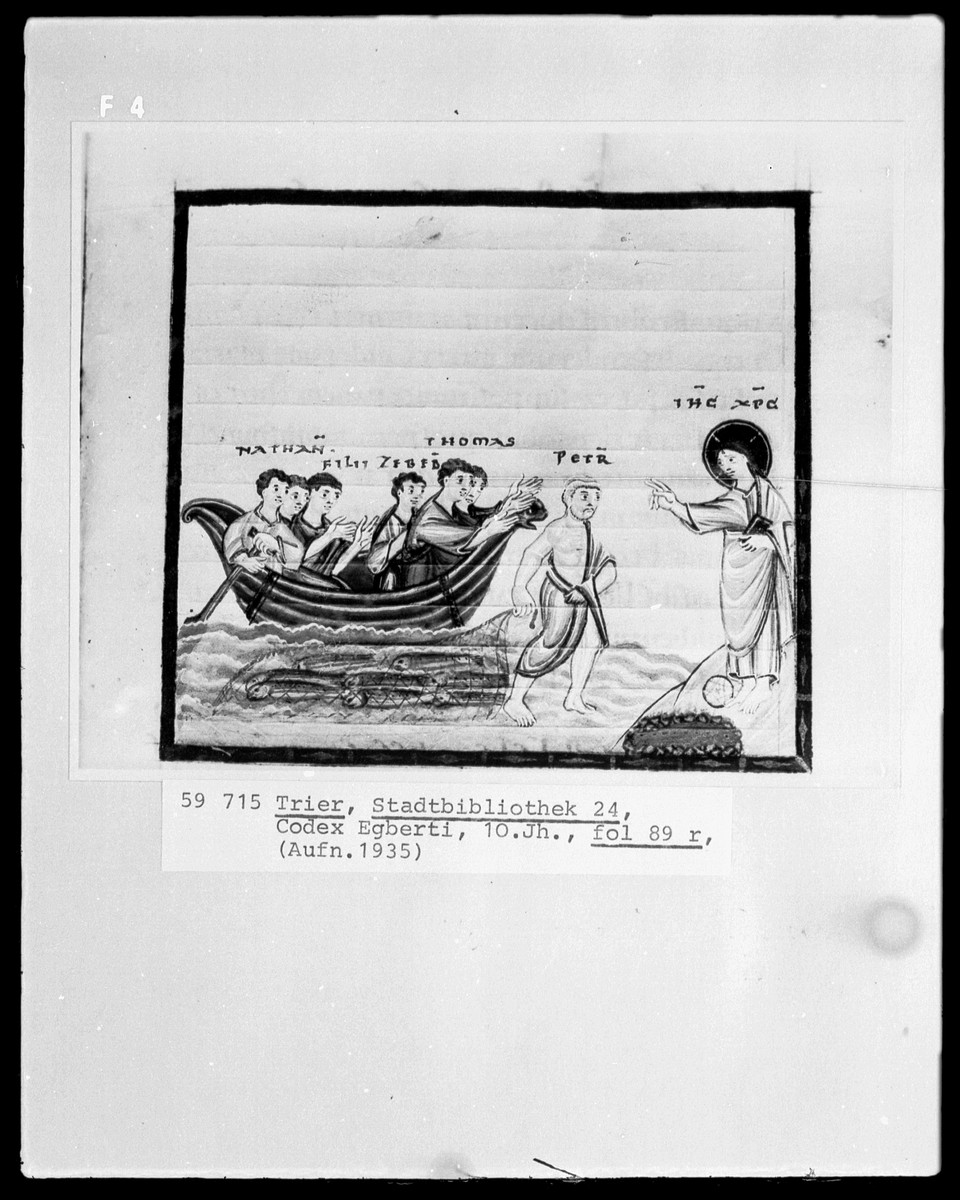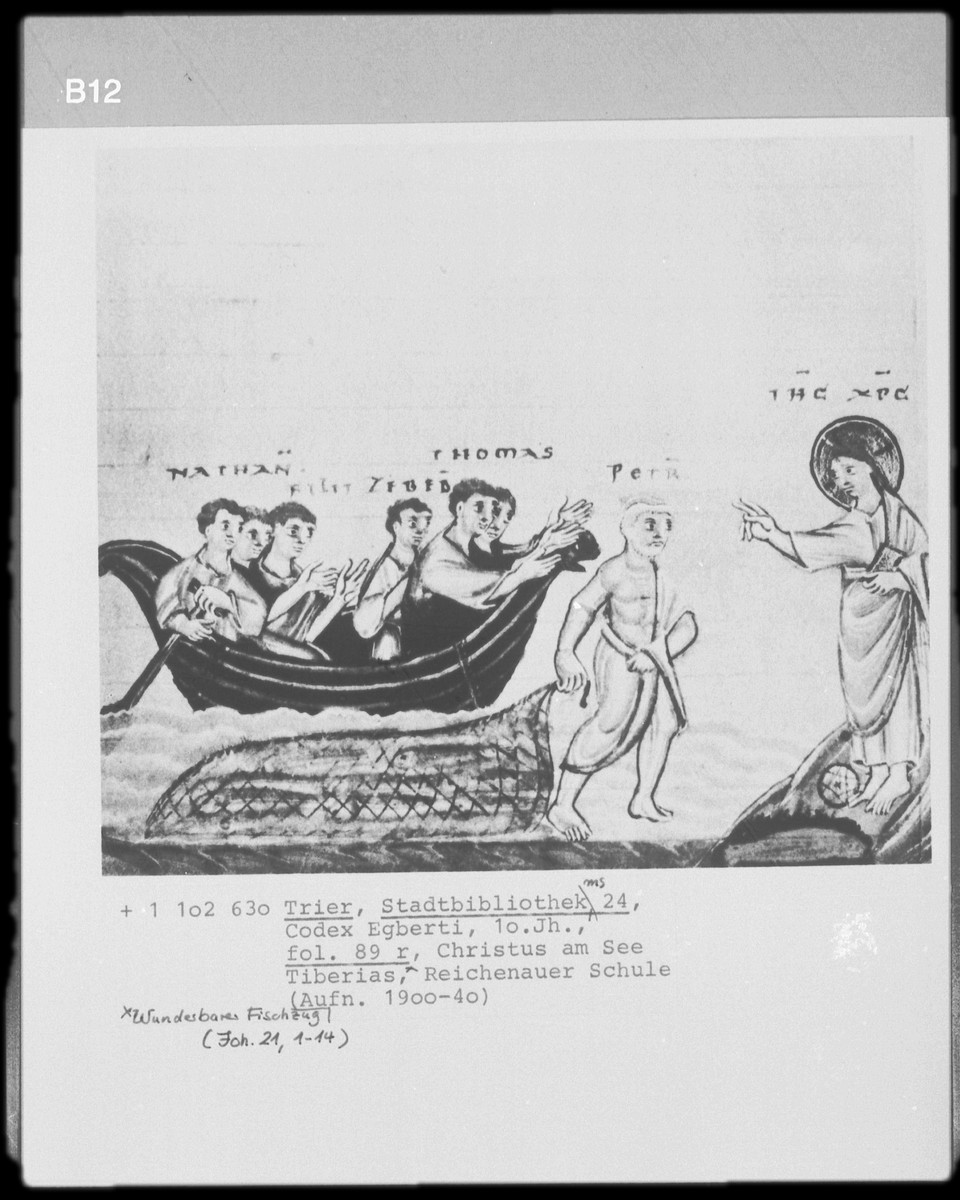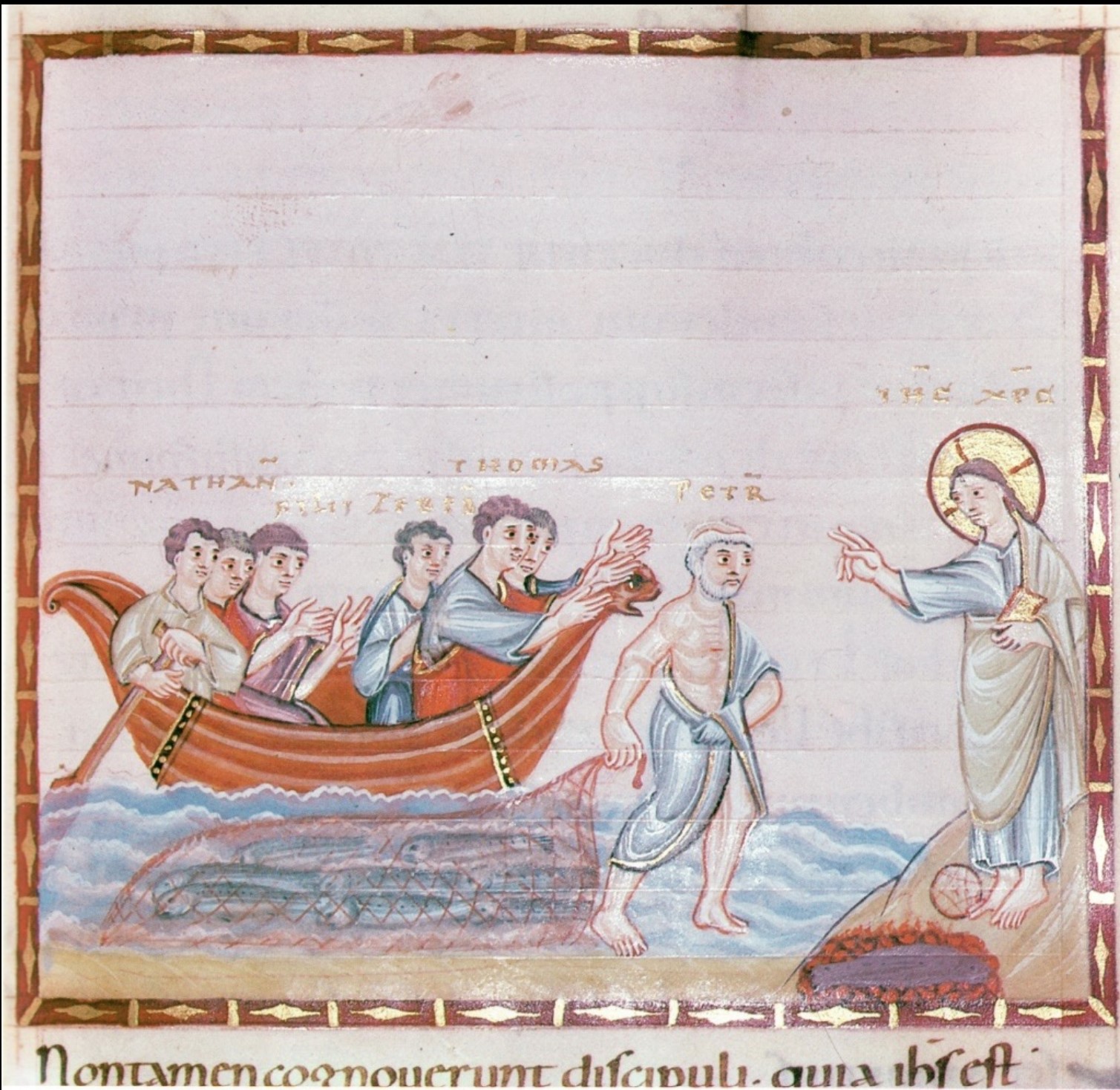Class notes
- Christ is in the shore as a sign of authority. Sea agains land, stability, dryness
- Different sources describe new/different situations, non biblical
- How do we interpret the fire, and all the symbols around?
- Codex Egberti, contrary to the Hungarian Angevine manustripts, is based in the gospel, not the legends
- It's still a fishing scene. Nets/media fish for people
Elements
- Gold and red borders to the scene
- 8 men: Christ, Peter, Thomas, Nathan, the sons of Zebedee (Filii Zebed_)
- A curvy boat in red, dragon head
- The lake Tiberiadis
- St Peter dressed as greek old man, grey and white
- Christ in golden aureal, holding a book(?), giving a blessing
- St Peter has the fishes by the right hand, red net
- There's a pentagram in the floor, also a pit of fire? A red ring with a center of dark color
Historical context
Der Codex Egberti, auch Egbert-Kodex genannt, ist ein Werk der ottonischen Buchmalerei. Das Evangelistar wurde für den Trierer Erzbischof Egbert zwischen 980 und 993 im Skriptorium des Klosters Reichenau erstellt. Es ist der älteste erhaltene neutestamentliche Bildzyklus mit Darstellungen aus dem Leben Christi.These works are typical in romanic art, based on byzantine Illuminatio codex as artist were received as refugees in the Carolingean court because of the Iconoclasm, were also the Merovingean Illuminatio (mostly ornamental) and the Saxon Illuminatio from scottish missions was blended together. Codex Egbertus in particular is from the Otonian Illuminatio, a consequence of the Carolingean Illuminatio, in general decorated with big Capital Letters, the main characteristic of the codices made in Reichenau. In particular, Codex Egbertus follows the Registrum Gregorii, some models are renovated, following (an probably with some access to italian originals) to older models in terms of icons.
Thoughts
The scene is interpreted traditionally (by whom?) as the poor conditions of humans,
short sighted thought, our inability to see Christ, the infinite shows in fron of them but it's not the man they knew as the master,
although to us it wears the signs, the book, the aureola, the cloth. The fire, the breakfast, invited to cotidianity.
Also the love, caught in the middle of a dream in the night that was the absense of the master.
Jesus in the bible stood by the beach, and invited them.
But you, "peasant", you can read it. Can you see Christ there? It's not just an old man there, it's ressurrected, it's in glory.
Provides some blessing, allows you to follow him and gave you fish and bread, it's waiting for you, the food of eternal life is here, take a seat.
There's strength, there's energy on the old St. Peter when he follows Christ, there's enthusiasm. The joy to have another encounter with your lord and protector.
We simply cannot forget that we are talking about Otonian period, a sort of renaissance in the territories north of the Alps, were the authority of the Emperor and the Pope were disputed
between them. The sack of italian cities might allow the northern monasteries to access the Illuminatio of the byzantines in exile that stayed around Ravenna. The usage of the Codex
was personal for the Erzbischof Egbert of Trier, an influential man and elector in the Electoral College of the (German) Roman Empire. As this man was well versed in the Bible,
probably the luxury and the access to the italian style was the local relevance of the text. We could also consider the role of St. Peter of vassal of Christ, just another old man
in the boat, not questioning a ressurrected Christ, maybe implying some sort of political propaganda against papal autonomy or preponderance: it's just another prince, no keys, just a man.
Probably influenced also by the Byzantine political situation naming popes in Rome from Constantinople: this (otonian) emperor was as emperor as the ones in Constantinople.
The fishing act on itself might be on those who run away from Christ/authority (see the fishes going to the left).
Additional pictures



Formal Analysis
The illumination demonstrates a synthesis of Byzantine influence with local Ottonian artistic traditions. Note the hierarchical scaling of figures, with saintly representations given prominence through size and central positioning.
Historical Summary
Created for Archbishop Egbert of Trier, this manuscript represents the flourishing of Ottoman art under imperial patronage. The codex served both liturgical and educational purposes within the archdiocese.
Biblical description
Codex Egberti, 980-993, fol. 90r. Jesus reveals himself to the disciples returning from the miraculous fishing on the Sea of Galilee. Stadtbibliothek Weberbach. The manuscript was named after its sponsor, the Trier Archbishop Egbert
Represents a piece of the bible: John 21
In the Vulgata:
1 Postea manifestavit se iterum Iesus ad mare Tiberiadis manifestavit autem sic
2 erant simul Simon Petrus et Thomas qui dicitur Didymus et Nathanahel qui erat a Cana Galilaeae et filii Zebedaei et alii ex discipulis eius duo
3 dicit eis Simon Petrus vado piscari dicunt ei venimus et nos tecum et exierunt et ascenderunt in navem et illa nocte nihil prendiderunt
4 mane autem iam facto stetit Iesus in litore non tamen cognoverunt discipuli quia Iesus est
5 dicit ergo eis Iesus pueri numquid pulmentarium habetis responderunt ei non
6 dixit eis mittite in dexteram navigii rete et invenietis miserunt ergo et iam non valebant illud trahere a multitudine piscium
7 dicit ergo discipulus ille quem diligebat Iesus Petro Dominus est Simon Petrus cum audisset quia Dominus est tunicam succinxit se erat enim nudus et misit se in mare
8 alii autem discipuli navigio venerunt non enim longe erant a terra sed quasi a cubitis ducentis trahentes rete piscium
9 ut ergo descenderunt in terram viderunt prunas positas et piscem superpositum et panem
10 dicit eis Iesus adferte de piscibus quos prendidistis nunc
11 ascendit Simon Petrus et traxit rete in terram plenum magnis piscibus centum quinquaginta tribus et cum tanti essent non est scissum rete
12 dicit eis Iesus venite prandete et nemo audebat discentium interrogare eum tu quis es scientes quia Dominus esset
13 et venit Iesus et accepit panem et dat eis et piscem similiter
14 hoc iam tertio manifestatus est Iesus discipulis cum surrexisset a mortuis
In the revised catholic:
1 After these things Jesus showed himself again to the disciples by the Sea of Tiberias; and he showed himself in this way.
2 Gathered there together were Simon Peter, Thomas called the Twin,[a] Nathanael of Cana in Galilee, the sons of Zebedee, and two others of his disciples.
3 Simon Peter said to them, “I am going fishing.” They said to him, “We will go with you.” They went out and got into the boat, but that night they caught nothing.
4 Just after daybreak, Jesus stood on the beach; but the disciples did not know that it was Jesus.
5 Jesus said to them, “Children, you have no fish, have you?” They answered him, “No.”
6 He said to them, “Cast the net to the right side of the boat, and you will find some.” So they cast it, and now they were not able to haul it in because there were so many fish.
7 That disciple whom Jesus loved said to Peter, “It is the Lord!” When Simon Peter heard that it was the Lord, he put on some clothes, for he was naked, and jumped into the sea.
8 But the other disciples came in the boat, dragging the net full of fish, for they were not far from the land, only about a hundred yards[b] off.
9 When they had gone ashore, they saw a charcoal fire there, with fish on it, and bread.
10 Jesus said to them, “Bring some of the fish that you have just caught.”
11 So Simon Peter went aboard and hauled the net ashore, full of large fish, a hundred fifty-three of them; and though there were so many, the net was not torn.
12 Jesus said to them, “Come and have breakfast.” Now none of the disciples dared to ask him, “Who are you?” because they knew it was the Lord.
13 Jesus came and took the bread and gave it to them, and did the same with the fish.
14 This was now the third time that Jesus appeared to the disciples after he was raised from the dead.
Iconographic Significance
This particular folio establishes visual conventions for saint representation that would influence subsequent German manuscript production. The gold background, while expensive, creates a hieratic space separating the sacred figures from the temporal world.
Conservation Note
The manuscript is currently housed in the Stadtbibliothek Trier. Digital facsimiles are available through the library's online collections.